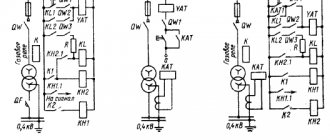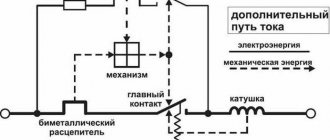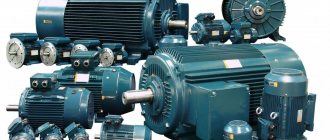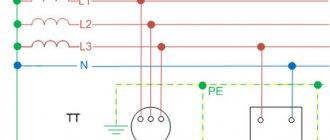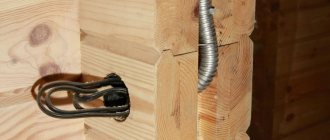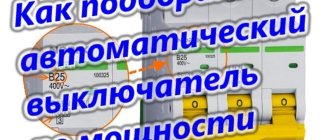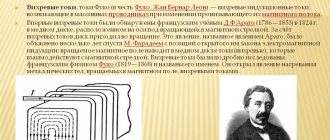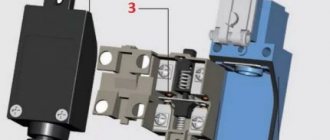The explanatory dictionary of the Russian language by Academician Ozhegov explains the meaning of the word “nominal”, as designated, called, but not fulfilling its duties, purpose, that is, fictitious.
This definition quite accurately explains the electrical terms of rated voltage, current and power. They seem to be there, assigned and defined, but in fact they only serve as guidelines for electricians. The actual numerical expressions of these parameters in reality differ from the assigned values.
The same picture can be seen with the rated current.
The basis for choosing its value is the maximum possible thermal heating of electrical conductors (including their insulation), which must operate reliably under load for an indefinitely long time. At rated current, a thermal balance is maintained between:
- heating of conductors from the temperature effect of electric charges, described by the Joule-Lenz law;
- cooling due to the removal of part of the heat to the environment.
In this case, heat Q1 should not affect the mechanical and strength characteristics of the metal, and heat Q2 should not affect the change in the chemical and dielectric properties of the insulation layer.
Even if the rated current value is slightly exceeded, after a certain period of time it will be necessary to remove the voltage from the electrical equipment to cool the metal of the current conductor and insulation. Otherwise, their electrical properties will be disrupted and breakdown of the dielectric layer or metal deformation will occur.
Any electrical equipment (including current sources, its consumers, connecting wires and systems, protective devices) is calculated, designed and manufactured to operate at a certain rated current. Its value is indicated not only in the technical factory documentation, but also on the housing or nameplates of the electrical equipment.
The above photograph clearly shows the rated current values of 2.5 and 10 amperes, which are made by stamping during the manufacture of an electrical plug. In order to standardize equipment, GΟST 6827−76 introduced a variety of rated current values at which almost all electrical installations must operate.
Rated current of the machine
The power consumption of different electrical appliances can vary thousands of times. Accordingly, the operating current is also different. For example, an ordinary apartment in a residential building consumes up to 16-32 A. Therefore, the apartment network circuit breaker is selected for a similar rating. High-power industrial furnaces can draw hundreds of amps from the power grid. Accordingly, they require a machine with a higher denomination.
Circuit breaker ratings
Selection of protective device
Since the rated current determines the possibility of long-term operation of electrical equipment without any damage, all current protective devices are configured to operate when it is exceeded.
In practice, situations quite often occur when an overload occurs in the power supply circuit for a short period for various reasons. In this case, the temperature of the metal conductor and the insulation layer do not have time to reach the limit when a violation of their electrical properties occurs.
For these reasons, the overload zone is allocated to a separate area, which is limited not only by its size, but also by its duration. When the critical temperature values of the insulation layer and conductor metal are reached, the voltage from the electrical installation must be removed to cool it. These functions are performed by so-called overload protections, which operate on a thermal principle:
- circuit breakers;
- thermal releases.
They perceive the thermal load and are configured to turn it off with a certain time delay. The setting of the protections that perform “instantaneous” load cutoff lies slightly above the overload current. The term "instantaneous" actually defines action in the shortest possible period of time. For today's fastest current protections, cutoff is performed in just under 0.02 seconds.
The operating current in normal power mode is most often less than the nominal value.
In the example given, the case for alternating current circuits is analyzed. In constant voltage circuits there is no fundamental difference in the relationships between the operating, rated current and the choice of settings for the operation of protections.
Type of electromagnetic splitter (switch-off curve)
The next parameter by which the circuit breaker is selected is the type of electromagnetic splitter. It is responsible for the delay that occurs when triggered. It is necessary to avoid false shutdowns during the start of motors of various equipment.
When you turn on the motor of a refrigerator, dishwasher or washing machine, the current in the circuit increases briefly. This phenomenon is called inrush currents, and they can exceed operating consumption by 10-12 times, but they do not last long. Such a short-term increase does not cause harm. So, the electromagnetic splitter must have a delay that allows you to ignore these inrush currents. This characteristic is displayed in Latin letters B, C, D. This letter is placed before the rating of the circuit breaker (photo). Selecting a circuit breaker based on this criterion is not difficult. You just need to know the nature of the planned load:
Actually, choosing a circuit breaker in this case is simple. On the lighting line it is enough to install category B machines; on the rest you can install C.
Rated short-circuit breaking capacity (Icu or Icn)
The breaking capacity of a low-voltage circuit breaker is related to the power factor (cos φ) of the faulted section of the circuit. A number of standards provide typical values for this ratio.
The breaking capacity of a circuit breaker is the maximum (expected) current that a given circuit breaker is capable of turning off and remaining operational. The current value mentioned in the standards is the effective value of the periodic component of the fault current, i.e. When calculating this standard value, it is assumed that the aperiodic component of the transient current (which is always present in the worst possible short-circuit case) is zero. This rated value (Icu) for industrial circuit breakers and (Icn) for household circuit breakers is usually specified in kA.
Icu (rated ultimate breaking capacity) and Ics (rated service breaking capacity) are defined in IEC 60947-2 together with the relationship between Ics and Icu for the different utilization categories A (instantaneous breaking) and B (delayed breaking) discussed in subsection Others characteristics of the circuit breaker.
Tests to confirm the rated breaking capabilities of circuit breakers are regulated by standards and include:
- switching cycles consisting of a sequence of operations, i.e. switching on and off during a short circuit;
- phase shift between current and voltage. When the current in the circuit is in phase with the supply voltage (cos φ = 1), cutting the current is easier to achieve than at any other power factor. It is much more difficult to switch off the current at low lagging values of cos φ, with current switching off in a zero power factor circuit being the most difficult case.
Table of dependence of machine power on wire cross-section
Each electrical wiring is divided into certain groups. Accordingly, each group uses an electrical wire or cable with a certain cross-section, and protection is provided by a circuit breaker with the most suitable rating.
The table will help you select a circuit breaker and cable cross-section depending on the expected load of the electrical network, calculated in advance. The table helps you make the right choice of machine based on load power. When calculating current loads, it should be remembered that load calculations for one consumer and a group of household appliances differ from each other. When making calculations, it is necessary to take into account the difference between single-phase and three-phase power.
The circuit breaker is designed to protect the electrical network to which consumers are connected. In this case, the total power of consumers should not exceed the power of the machine itself. Therefore, it is necessary to correctly select the machine according to the load power. How can this be done, is there one way to choose or are there several?
Rated currents of different devices
Here's how much current some devices consume:
- electric stove: power - from 1.2 to 6 kW, cosϕ = Rated current: from 1200 / 220 = 5.45 A to 6000 / 220 = 27.25 A;
- heater : 0.5 - 2 kW, cosϕ = 1. Current - from 2.3 A to 9.2 A;
- vacuum cleaner : 0.5 – 2 kW, cosϕ = 0.9. Current: from 500 / (220 * 0.9) = 2.52 A to 2000 / (220 * 0.9) = 10.1 A;
- iron : 1–2 kW, cosϕ = 1. Current: 4.6–9.2 A;
- hair dryer : 0.6–2 kW, cosϕ = 1. Current: 2.76–9.2 A;
- TV : 0.1–0.4 kW, cosϕ = 1. Current: 0.46–1.84 A.
Classes (operation characteristics) of circuit breakers
The most used classes are B, C and D. Used in household, lighting and other networks with little or no inrush current. Such machines are installed directly at the consumer’s premises. The electromagnetic release in such devices is triggered when the current exceeds 3 times or more.
It is recommended to install in networks with mixed loads and moderate inrush currents. Also used in household networks, but protect a group of consumers. The most popular machine among electricians. They have a greater overload capacity compared to class B devices. The minimum operating current must exceed the nominal value by 5 or more times.
Devices of this class protect electric motors whose starting current significantly exceeds the rated current. They have a high overload capacity. The minimum operating current is ten rated.
Selection of circuit breakers
Since an increase in current strength above the rated value (overload) entails disruptions in the operation of devices, in this case it is necessary to provide for de-energizing the circuit.
The task is performed by the following protection devices:
- fuses: contain a fusible insert - when overheated, it melts and the circuit opens;
- automatic switches (VA).
VA consists of two parts:
- thermal release . Bimetallic plate that opens contacts when heated. The response time can be tens of minutes;
- electromagnetic release (coil with solenoid). Triggers almost instantly (0.02 s) when the current reaches a certain value.
The operating threshold of the electromagnetic release for different consumers also requires an individual one. Some fail even with the slightest overload, others can withstand 14 times the excess of In. Therefore, they produce 4 classes of VA, differing in the setting of the electromagnetic device for breaking the circuit (cut-off current setting): A, B, C and D.
The class is selected according to the type of consumers:
- semiconductor elements. Class A, the most sensitive: cut-off current - 2 times higher than the rated current;
- sockets, lighting circuits and others where inrush currents are absent or small. Class B: cut-off current - 3 times higher than the rated current;
input devices for household electrical networks. Class C: cut-off current - 5 times higher than the rated current. Such VAs are not used alone: they ensure the security of the network as a whole, while each group (sockets, lighting) is additionally protected by a class B VA. That is, a class C VA insures class B machines, but in the event of an overload in one of the groups, the entire the network is not de-energized (selectivity);- input devices for networks of buildings and structures, circuits with high starting currents (electric motors act as consumers). Class D: cut-off current - 10 times higher than the rated current. At the entrance to the building, such a VA also plays the role of a selective one - it insures circuit breakers on floors and in individual rooms.
When an overload is less than the cut-off current setting, a current in excess of the rated current flows through the circuit for some time (before the thermal release is activated).
This is taken into account, for example, when choosing an RCD, officially called a “residual current switch”. This is another protective device that de-energizes the circuit when a current leak is detected, thereby preventing electrical injury to the user.
The RCD is selected with a rated current that is one step higher than the corresponding parameter of the VA protecting it.
Rated short-circuit breaking capacity (Icu or Icn)
The breaking capacity of a low-voltage circuit breaker is related to the power factor (cos φ) of the faulted section of the circuit. A number of standards provide typical values for this ratio.
The breaking capacity of a circuit breaker is the maximum (expected) current that a given circuit breaker is capable of turning off and remaining operational. The current value mentioned in the standards is the effective value of the periodic component of the fault current, i.e. When calculating this standard value, it is assumed that the aperiodic component of the transient current (which is always present in the worst possible short-circuit case) is zero. This rated value (Icu) for industrial circuit breakers and (Icn) for household circuit breakers is usually specified in kA.
Icu (rated ultimate breaking capacity) and Ics (rated service breaking capacity) are defined in IEC 60947-2 together with the relationship between Ics and Icu for the different utilization categories A (instantaneous breaking) and B (delayed breaking) discussed in subsection Others characteristics of the circuit breaker.
Tests to confirm the rated breaking capabilities of circuit breakers are regulated by standards and include:
- switching cycles consisting of a sequence of operations, i.e. switching on and off during a short circuit;
- phase shift between current and voltage. When the current in the circuit is in phase with the supply voltage (cos φ = 1), cutting the current is easier to achieve than at any other power factor. It is much more difficult to switch off the current at low lagging values of cos φ, with current switching off in a zero power factor circuit being the most difficult case.
Time-current characteristics (VTC) of circuit breakers
Introduction
As is known, automatic circuit breakers can have the following types of releases that provide protection of the electrical circuit from overcurrents: electromagnetic - protecting the network from short circuits, thermal - providing protection from overload currents and combined, which is a combination of electromagnetic and thermal releases (for more details, read the article “circuit breakers”).
Note: Modern circuit breakers designed to protect electrical networks up to 1000 Volts usually have combined releases.
Circuit breaker releases are actuators that ensure disconnection (disengagement) of an electrical circuit when a current higher than the permissible one occurs in it, and the greater this excess, the faster the disconnection should occur.
The dependence of the tripping time of a circuit breaker on the magnitude of the current passing through it is called the time-current characteristic or abbreviated as VTC .
Conditions and values of VTX
The performance characteristics of the machines are determined by the following values:
1) Instantaneous trip current - the minimum current value that causes automatic operation of the circuit breaker without a deliberate time delay. (GOST R 50345-2010, clause 3.5.17)
Note: operation without a deliberate time delay is ensured by the electromagnetic release of the machine.
The instantaneous tripping current is determined by the so-called “trip characteristic” or, as it is also called, the tripping characteristic.
According to GOST R 50345-2010, there are the following types of circuit breaker response characteristics:
Note: there are also other, non-standard types of characteristics, we talked about them in the article “circuit breakers“.
As can be seen from the table above, the instantaneous tripping current is indicated as a range of values, for example, characteristic “B” assumes that the machine will provide instantaneous tripping when a current flowing through it is 3 - 5 times greater than its rated current, i.e. If a circuit breaker with this characteristic has a current rating of 16 Amps, then it will provide instantaneous tripping at a current of 48 to 80 Amps.
The response characteristics of a circuit breaker can usually be determined by the markings on its body:
2) Conditional non-trip current - a set value of the current that the circuit breaker is capable of conducting without tripping for a given (conditional) time*. (GOST R 50345-2010, clause 3.5.15) According to clause 8.6.2.2 of GOST R 50345-2010, the conditional non-trip current is equal to 1.13 of the rated current of the machine. 3) The verbal trip current is a set current value that causes the circuit breaker to trip within a specified (conditional) time*. (GOST R 50345-2010, clause 3.5.16) According to clause 8.6.2.3 of GOST R 50345-2010, the conditional tripping current is equal to 1.45 of the rated current of the machine.
* The conditional time is 1 hour for switches with a rated current up to 63 A inclusive and 2 hours with a rated current over 63 A. (GOST R 50345-2010, clause 8.6.2.1)
The time-current characteristic of the circuit breaker is determined by the conditions and values given in Table 7 of GOST R 50345-2010 :
Note: The table is valid for machines installed in accordance with the test conditions given below and operating at a temperature of 30 +5 ° C
VTX charts
For convenience, manufacturers in the passports for circuit breakers indicate the time-current characteristics in the form of a graph where the X axis shows the multiple of the electrical circuit current to the rated current of the circuit breaker (I/In), and the Y axis shows the tripping time of the release.
For a detailed consideration, let’s take as an example the VTX graph for a circuit breaker with characteristic “B”
NOTE: All graphs below are provided as an example. Different manufacturers' performance characteristics may differ (see the machine's passport), but in any case they must comply with the requirements of GOST R 50345-2010 and, in particular, the values specified in Table 7 above.
As you can see, the VTX graph is represented by two curves: the first curve (red) is the characteristic of the machine in the so-called “hot” state, i.e. machine is in operation, the second (blue) is the characteristic of the machine in a “cold” state, i.e. machine through which electric current has just begun to flow.
At the same time, the blue curve has an additional dashed line, this line shows the characteristics of the machine (its thermal release) with a rated current of up to 32 Amperes, this difference in the characteristics of machines with ratings up to and above 32 Amperes is due to the fact that in machines with a higher rated current there is a bimetallic plate The thermal release has a larger cross-section and, accordingly, it needs more time to warm up.
Selecting the degree of protection against short-circuit currents (cut-off current)
The second function of the protective circuit breaker is to turn off the power when excess currents appear that occur during a short circuit (short circuit). Circuit breakers are designed for different values of these currents, and the characteristic that displays it is the breaking capacity or cut-off current. It shows at what short-circuit current the machine will still remain in working condition. The fact is that the burster does not fire instantly, because there is a delay in response to ignore starting overloads. During this delay, the contacts may melt and the device will become inoperable. So, the cut-off current or breaking capacity shows how much current the contacts can withstand without compromising performance.
In the household electrical network, circuit breakers are used with three degrees of protection against short-circuit currents: 4500 A, 6000 A, 10000 A. On the device body, these numbers are placed in a frame just below the rating of the machine. In terms of price, the difference is quite noticeable, but it is justified - more “resistant” bags use refractory materials, and they are much more expensive.
How to choose a circuit breaker in this case? The choice depends on the location of the network relative to the substation. If a house or apartment is located nearby, the short-circuit currents can be very large, therefore the breaking capacity should be at least 10,000 A. If the household is located in a rural area, the networks there are old and/or the supply occurs via an overhead network, an automatic circuit breaker with a breaking capacity of 4,500 A is sufficient In all other cases they set it to 6000 A.
